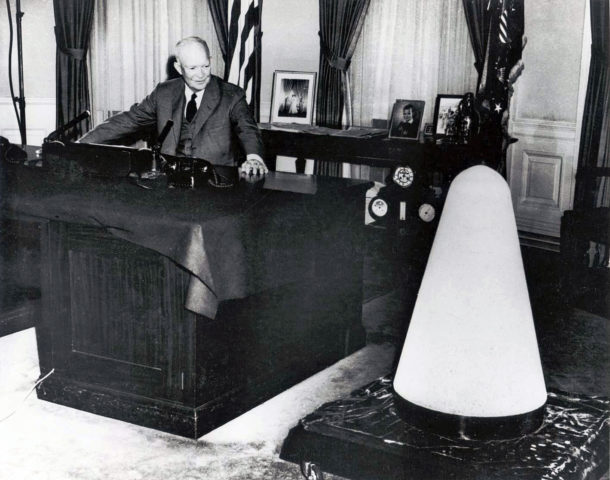
Sixty years ago this month, the first ablative nose cone to survive entry into the Earth’s atmosphere was formally presented to the American public. President Dwight D. Eisenhower displayed the recovered nose cone during a national television broadcast from the Oval Office.
An object making a hypersonic entry into the the Earth’s atmosphere from space possesses a great deal of kinetic energy. This energy of motion is transformed to thermal energy as aerodynamic drag slows the vehicle during atmospheric flight. A portion of the entry thermal energy is absorbed by the vehicle structure in a process referred to as aerodynamic heating. This heat transfer process causes the temperature of the external surface of the vehicle to significantly increase.
From a vehicle survivability standpoint, three parameters are key; (1) maximum heat transfer rate, (2) maximum surface temperature and (3) total thermal energy absorbed by the vehicle during entry. The concern is that there is enough kinetic energy in the entry flight domain to vaporize any known material if that energy is completely absorbed by the vehicle.
One has only to look into the heavens at night to become convinced of the ferocity of the entry environment. The streaks of white, yellow, green, blue, or red light that dramatically flash into and out of existence are associated with the vaporization of meteors transiting the atmosphere. Few meteors have enough pre-entry mass to allow a minor portion thereof to reach the ground. Those that do are referred to as meteorites.
The problem of surviving atmospheric entry was a major research topic in the 1950’s. Attention focused on protecting the nuclear warhead carried by the reentry vehicle of an Intercontinental Ballistic Missile (ICBM). A pair of research scientists at the NACA Ames Research Center in California, H. Julian Allen and Alfred J. Eggers, are credited with solving the problem. The key was to hemispherically-blunt or round the nose of a reentry vehicle.
A blunted forebody disposes a detached, hyperbolic-shaped shock wave which slows the post-shock flow to subsonic speeds in the stagnation region. A byproduct of this flow deceleration is a significant increase in post-shock static pressure and temperature. While this dramatically increases vehicle wave drag, most of the high temperature air passes around the vehicle and thus never physically comes in contact with it. The result is that only a small fraction of the overall thermal energy of the freestream flow is convected to the vehicle surface.
In contrast to the above, a sharp-nosed vehicle nose disposes an attached, highly-swept shock wave. This flow topology results in a large fraction of the overall thermal energy being convected to the vehicle surface. The is because the degree of post-shock flow slowing in such a situation is small. Indeed, the post-shock flow has a high supersonic Mach number. Now, due to the “no-slip” condition caused by fluid viscosity, the flow velocity at the vehicle surface is zero. Thus, the bulk of the flow deceleration has to occur within the boundary layer. The huge shearing stresses and temperature gradients that result generate extreme heat flux rates at the vehicle surface.
On Thursday, 08 August 1957, a Jupiter-C launch vehicle carrying a one-third scale version of a Jupiter IRBM nose was launched from LC-6 at Cape Canaveral, Florida. The nose cone traveled 1,168 nautical miles, reaching nearly 9,000 mph and an altitude of 260 nautical miles in the process. During reentry an ablative heat shield was used to protect the nose cone from the aerodynamic heating environment. The vehicle parachuted into the Atlantic Ocean and was recovered by Navy swimmers within three hours of launch.
On Thursday, 07 November 1957, President Dwight D. Eisenhower displayed the recovered Jupiter IRBM scaled nose cone in a nationally televised broadcast from the Oval Office. The excellent condition of the recovered vehicle was a stark testament to the effectiveness of a blunted, ablative nose cone to weather the rigors of reentry heating. This historic breakthrough would forever change the science of atmospheric entry. Indeed, it would ultimately make possible successful entry of Apollo astronauts returning from the Moon at 25,000 mph.
Today, one can view the recovered Jupiter IRBM subscale nose cone at the Smithsonian’s National Air and Space Museum in Washington, DC. Specifically, it is on public display in the Space Race Exhibition at the National Mall Building.

